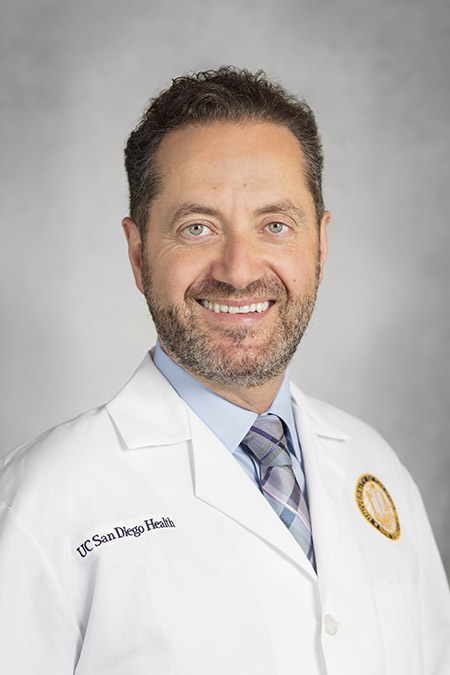New 3D Technology Can Repair Aneurysms Previously Deemed Inoperable
UC San Diego Health surgeons perform procedure in half the time, with minimal iodine contrast
Published Date
By:
- Debra Kamin
Share This:
Article Content
Surgeries to repair complex thoracoabdominal aortic aneurysms are difficult and sometimes fraught with complications. Up to 25 percent of patients who undergo the vascular procedure experience subsequent renal problems caused by contrast dyes needed to pinpoint the locations of major vessels originating near or from the life-threatening arterial bulges.
Surgeons at UC San Diego Health are using a new imaging technology that harnesses artificial intelligence and machine learning to reduce the need for contrast agents, the patient’s time in surgery and the potential for post-operative kidney complications. UC San Diego Health is among the first health care systems in the nation to offer the technology.

Mahmoud Malas, MD, chief of Vascular and Endovascular Surgery at UC San Diego Health, has seen his operating time cut in half thanks to the new technology.
The aorta is the primary artery carrying blood from the heart to the rest of the body. Aortic aneurysms occur when the walls of the artery weaken and lose their elasticity, resulting in a balloon-like bulge. The damaged tissue may eventually rupture without warning — with fatal consequences.
In traditional endovascular repair of aortic aneurysms, surgeons use contrast dyes to reveal the size and scope of the aneurysm, then X-rays are used to guide a stent graft — a plastic- or fabric-coated metal tube — to the weakened section of arterial wall to prevent it from tearing.
The new technology, called Dynamic Morphology Correction and developed by United Kingdom-based Cydar Medical, allows surgeons to work faster with more precision and with minimal contrast dye.
Instead, surgeons rely upon dynamic 3D image overlays of the human body, built using computerized prediction models based on the patient’s pre-operative X-ray and anatomy. The models allow surgeons to minimize iodine contrast and its risk to kidneys, lower radiation exposure during surgery and measurably reduce time on the operating table.
“It allows me to fix aneurysms that were very difficult to fix before, and I can do it knowing that I’m reducing my radiation and contrast volume to my patients,” said Mahmoud Malas, MD, chief of Vascular and Endovascular Surgery at UC San Diego Health.
Aortic aneurysms occur primarily in men over the age of 60 when arteries have become more twisted and the use of stiff stents and wires is more challenging.
“This is a disease of the elderly,” Malas said. “In the past, we would sometimes have to say, ‘We’re sorry, but we just can’t help.’ This technology has opened up a new way for us to treat people we couldn’t previously.”
Cydar’s technology builds a 3D model of a patient’s aneurysm and surrounding vessels using a pre-operative CT scan. On the day of surgery, surgeons take a real-time image of the patient’s body with two bone landmarks within the CT scan. The data is fused with the pre-operative image to form a 3D reconstruction of the image which the surgeon can use in the operating room as a guide to the aneurysm and its treatment, while preserving major aortic branches that feed the kidneys, bowels and liver.
“In the past, we would use a significant amount of contrast to just localize the visceral vessels, which could damages the kidneys” Malas said. “This is significantly more accurate than before, and I get into the major vessel with my catheter within a minute and without any contrast. We used to spend eight-to-10 hours on these procedures. Now we can do them in half the time.”
Share This:
You May Also Like
Stay in the Know
Keep up with all the latest from UC San Diego. Subscribe to the newsletter today.



